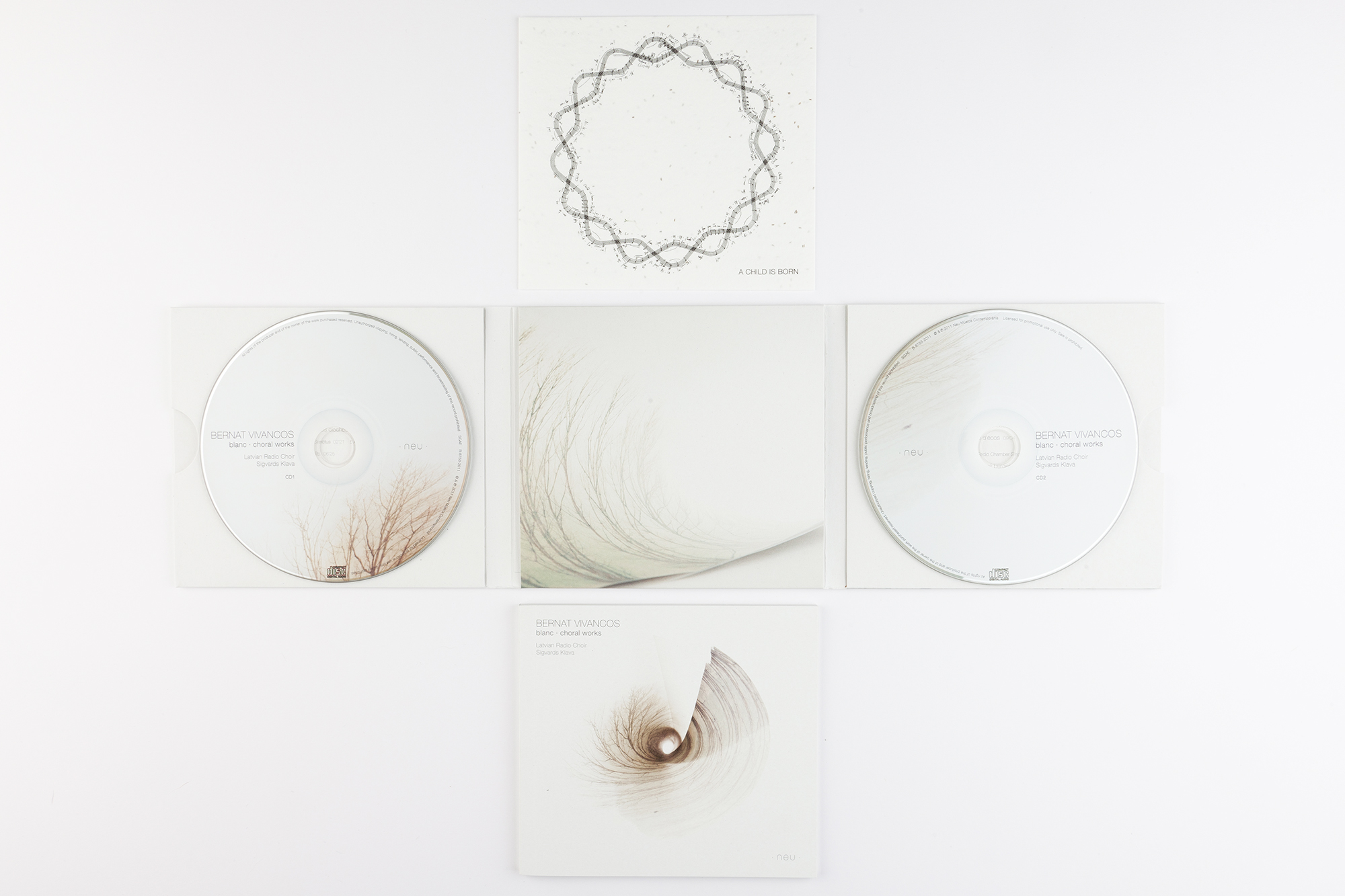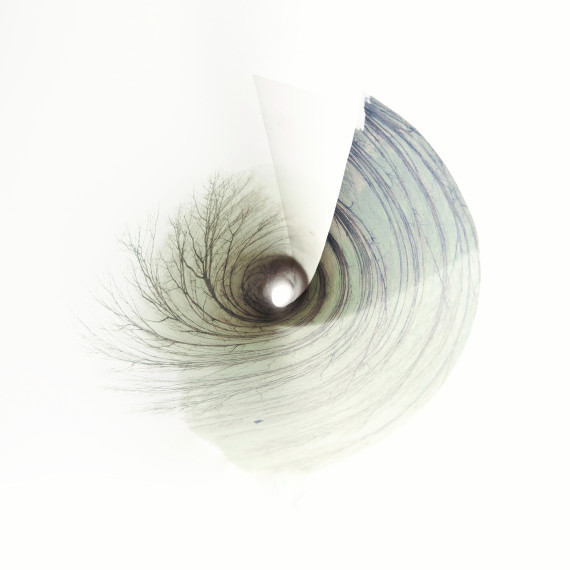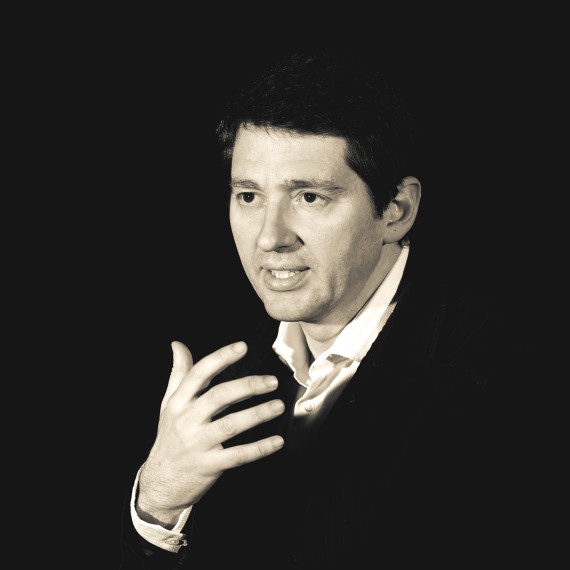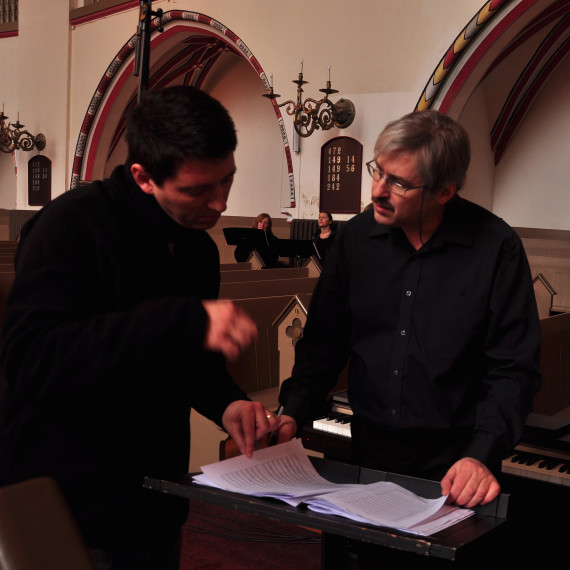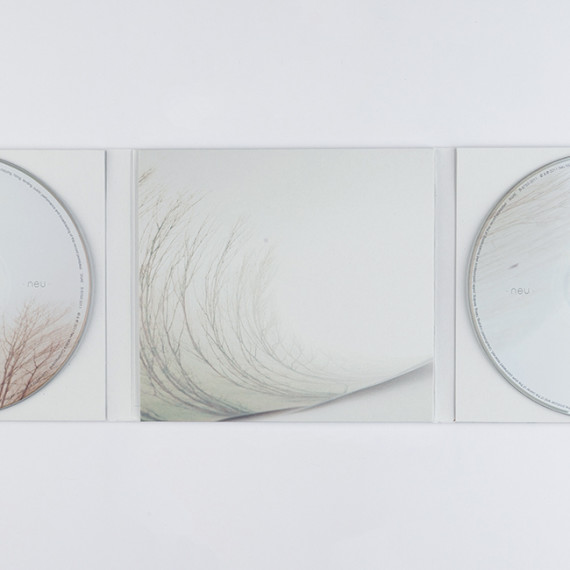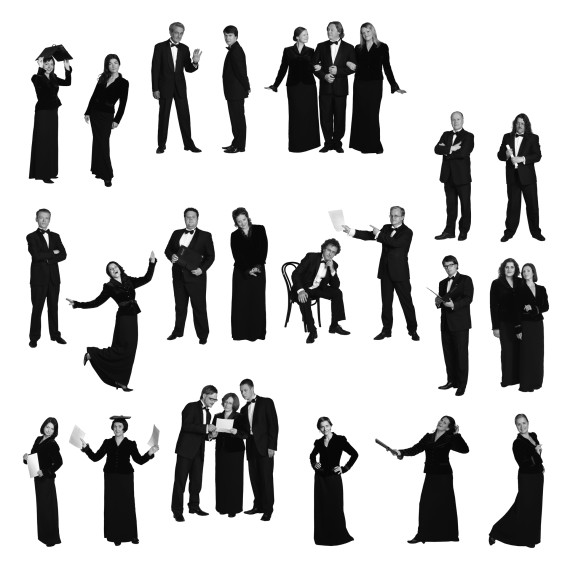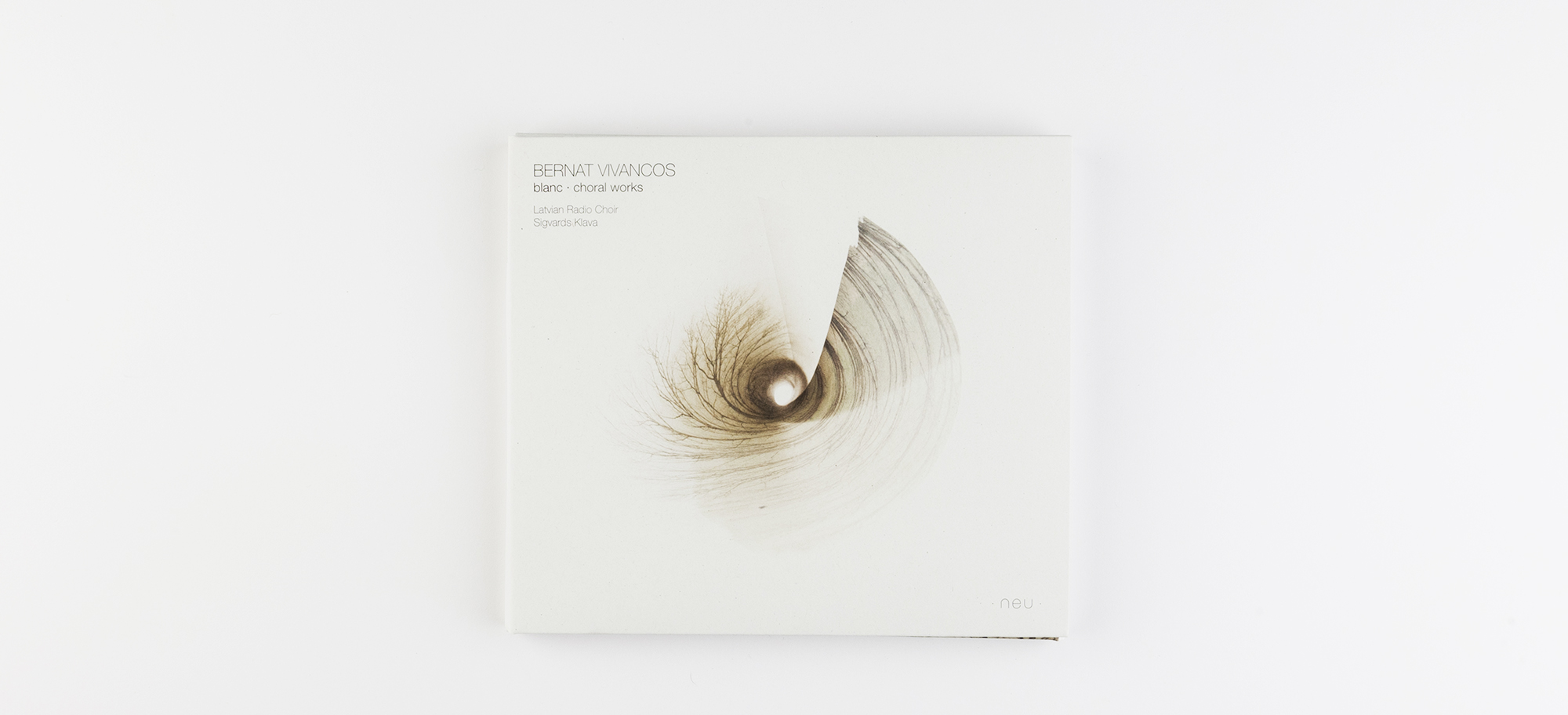
Latvian Radio Choir, Sigvards Klava
“Bernat Vivancos’ music is like a city of angels: blissful sounds populated by saintly spirits hiding between the notes as birds in a tree”
Lasse Thoresen
“If I did select CDs of the the year Bernat Vivancos’ Blanc – Choral Works would be up for a prize, as would Neu Records in the label of the year category”
On An Overgrown Path
“Une révélation”
Vic Nees
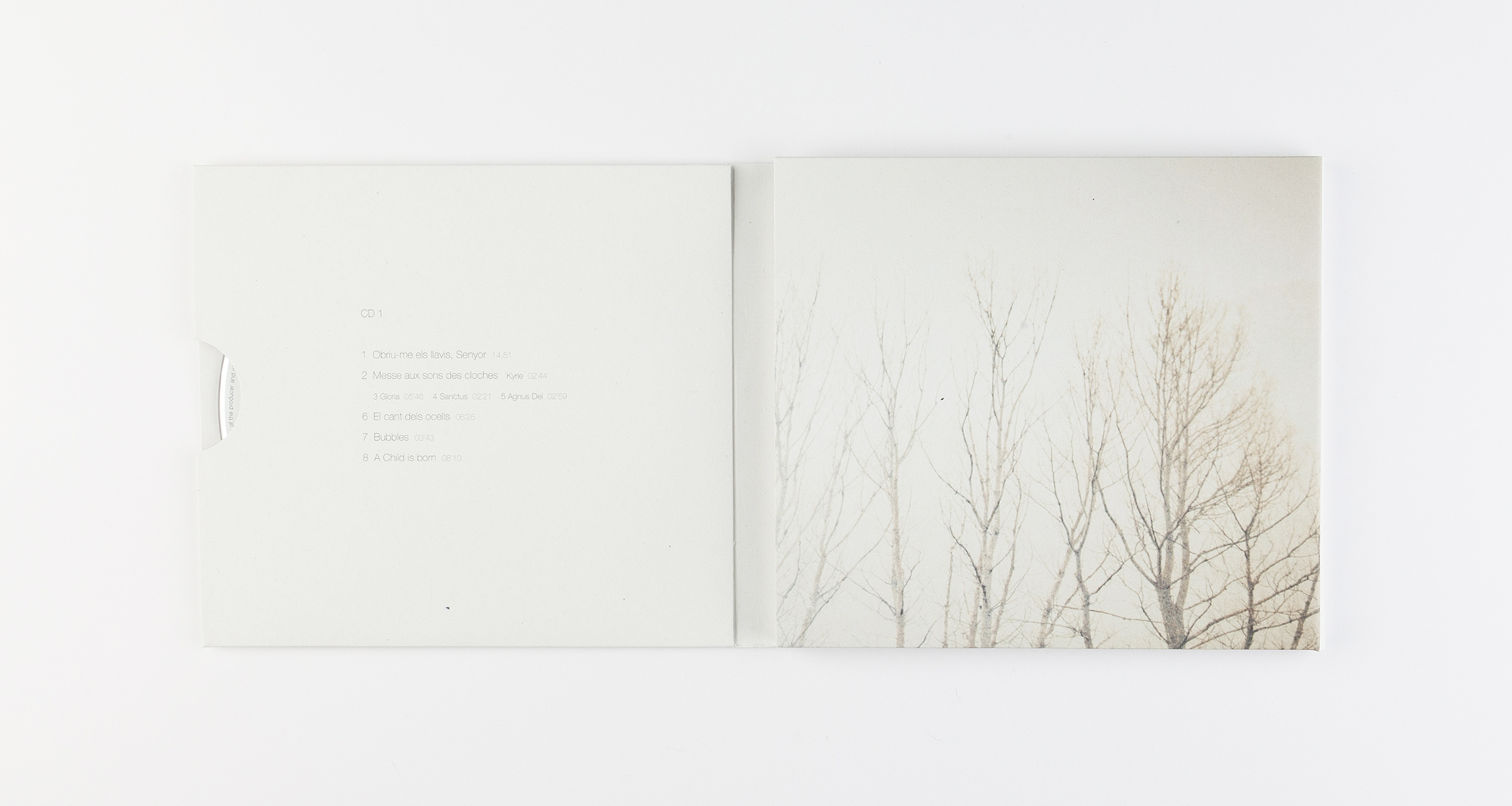
1. |
Obriu-me els llavis, Senyor |
14:51 |
for mixed choir |
Messe aux sons des cloches |
for mixed choir and five percussionists |
2. |
Kyrie |
02:44 | |||||||
3. |
Gloria |
05:46 | |||||||
4. |
Sanctus |
02:21 | |||||||
5. |
Agnus Dei |
02:59 |
6. |
El cant dels ocells |
06:25 |
for soprano and mixed choir |
7. |
Bubbles |
03:43 |
for mixed choir and four percussionists |
8. |
A Child is born |
08:10 |
for mixed choir |
9. |
Nigra Sum |
08:39 |
for women's choir |
10. |
Salve d'ecos |
09:04 |
for women's choir |
11. |
Le cri des bergers |
05:35 |
for tenor and chamber choir |
12. |
Nigra es pulchra sum |
15:45 |
for six soloists |
Buy Album
2 CD Special Edition
Included formats
2 CD + Voucher Code to download:
HD FLAC Stereo · 24 bit 96 kHz
HD ALAC Stereo · 24 bit 96 kHz
HD FLAC Surround 5.1 · 24 bit 96 kHz
MP3 · 320 kbps
21,90€
Digital Album in CD Quality
Included formats
FLAC Stereo · 16 bit 44,1 kHz
ALAC Stereo · 16 bit 44,1 kHz
MP3 · 320 kbps
10,00€
Digital Album in HD Quality
Included formats
HD FLAC Stereo · 24 bit 96 kHz
HD ALAC Stereo · 24 bit 96 kHz
HD FLAC Surround 5.1 · 24 bit 96 kHz
MP3 · 320 kbps
14,00€
Vivancos’ cities of angels
Bernat Vivancos’ music is like a city of angels: blissful sounds populated by saintly spirits hiding between the notes as birds in a tree. In saying so I do not simply refer to his string orchestra piece of the same name; rather, I think this title may well serve as a motto for all of his vocal music.
Bernat Vivancos’ musical personality is permeated with the impressions that he received as a choir boy and music student at Montserrat – the eldest existing music conservatory in the Western world, and a sacred place for the Catalonian Catholics. The church with its black Madonna, the legends about the foundation of the church and the monastery, the location of the church in a mountain crevice among phallic looking mountain peaks – all this suggests mystery, adoration, devotion, and the freeing of man’s spirit from daily struggle and worry through its ascension into a sphere of heavenly dreams and visions. This atmosphere is embedded in Vivancos’ music, above all in his choral setting of sacred text. For the human voice is the privileged medium in practically all the world’s religions for heightening the sense of the sacred in connection with the recitation of the Holy Words.
Bernat Vivancos being a pious, former choral boy from a musical and highly cultivated family, could have easily contented himself with ending his musical education once he had become an organist, a brilliant pianist and a highly qualified composer in a traditional stylistic idiom. Instead he chose to challenge this safe musical identity by submitting himself to the rigors of modernist composition at the Conservatoire National Supérieur de Musique et de Danse de Paris. The encounter with music based on sound rather than on notes – music that had neither a describable harmony nor a metrical structure – created a tension in the musical personality of this young composer, one that had to be resolved in a synthesis of a new kind. Some of the keys to this synthesis he found during a half-year stay at the Norwegian Academy of Music, as a consequence of which he was eventually able to shape his own, original style of composition. He chose to remain faithful to his spiritual, musical ideals: he continued making music that had harmony as its basis, and cultivating musical expressions of love and praise. Yet he filtered out from contemporary music elements that changed his conception of musical texture and form, and made an original synthesis of new and old.
The young composer’s erudition and sociability made him a natural choice for the job as professor of composition and orchestration when the Escola superior de música de Catalunya was started a few years ago. But at the same time, his musical roots at Montserrat made their claim on him: he was called as the new conductor of the Monastery’s Boys’ Choir in 2007. Every week of the year he appears several times with his choir in the venerable church which is visited by thousands of believers, tourists and music lovers. He has also the privilege to serve as mentor and example for the boys who receive a full music education in the music conservatory of the Monastery.
Bernat’s music has resisted the exclusiveness of elitist modernity while reaping the benefits from his thorough studies of it. Staying loyal to the musical impressions that first shaped his musical personality, he is now in a position to communicate with a really great number of devoted listeners, conveying to them the secrets of the angels that hover above the Holy Mount.
Lasse Thoresen
ABOUT THE WORKS
This album comprises a selection of Bernat Vivancos’ most evocative choral works, and reflects an aesthetic approach that the composer began to develop during his stays in Paris and Oslo. Since then, Vivancos’ style has incorporated elements that make his music a unique proposition: music of rich sonority, texture and colour, where research into spectral inspired harmonies, western traditional modal music, and a constant interest to create a new and seductive dimension all converge, and where being transported by the sound itself is one of the main attractions.
Contemplation and transcendence, always present in his music, are captured in works of great beauty, as “Nigra sum”, in which female voices elucidate the blackness of the Black Madonna venerated in the Shrine of Montserrat. Other works maintain a direct relationship with motifs or elements of other authors which inspire his melodic work, like “Salve d’ecos” (on a Salve Regina by Claudio Monteverdi), the “Sanctus” from “Messe aux sons des cloches” (invocation of the Gregorian Mass for the Dead), or “Obriu-me els llavis, Senyor”, which magnifies with 5 choirs Monk Gregory Estrada’s song, sung daily at dawn at Matins by the Benedictine community of Montserrat.
The study of spatial sound is present in much of his music and is represented in “Bubbles”, “Le cri des Bergers” and also in “Obriu-me els llavis” and “Salve d’ecos”, where artificial resonances and polichorality give the listener a unique perception of the choir. In the “Messe aux sons des cloches” the timbre of mixed voices mingles with the inspiring sound of 5 sets of strategically placed tubular bells and tam-tams. Other works of ascetic simplicity, like “A Child Is Born”, are built on musical calligrams based on texts and on a complementary musical pattern, forming a circle that could go infinitely. “El cant dels ocells” -song of praise to the divine child and symbol of peace and freedom in Catalonia and around the world- is surrounded here by a halo of static sounds and modal harmonies, with the aim of avoiding traditional harmonization. And in “Nigra es, Pulchra sum” and “Nigra sum”, sensuality and spirituality manifest jointly, recovered in a dream world. The biblical book “Song of Songs” becomes thus the source of inspiration in which seduction and faith converge.
BERNAT VIVANCOS · BLANC
Official Video
BERNAT VIVANCOS TALKS ABOUT BLANC
Interview with Bernat Vivancos in Rupit, Catalonia.
Here is the full score of Blanc. The document, in pdf format, includes explanatory notes by the composer (in English, French, Catalan and Spanish) and diagrams for placing the musicians for each piece, as well as percussion scores. This score, free from publishing rights but subject to authors copyright, is available for performance or study of all kinds.
DOWNLOAD FULL SCORES (PDF)
Bernat Vivancos · Photos
Bernat Vivancos, Blanc, RequiemRecording Blanc · Photos
Bernat Vivancos, Blanc, Latvian Radio Choir, Sigvards KlavaBlanc · Album Images
Bernat Vivancos, Blanc, Latvian Radio Choir, Sigvards KlavaLatvian Radio Choir · Photos
Blanc, Latvian Radio Choir, Requiem“If I did select CDs of the the year Bernat Vivancos’ Blanc – Choral Works would be up for a prize, as would Neu Records in the label of the year category. Read more.”
Bob Shingleton, ON AN OVERGROWN PATH
“Vivancos’ evocative works are rich in sonority, texture and colour”
Gavin Engelbrecht, NORTHERN ECHO
“An impeccable performance of a capella choral works by Bernat Vivancos, a composer who possesses a vast knowledge of choral music and is blessed with great creative abilities. (…) Music that strikes a perfect understanding between images, colours, devotion and translucence, on the border between echo and memory.”
RNE RADIO CLÁSICA. SPANISH NATIONAL RADIO
“Blanc contains a work of extraordinary delicacy and high quality, in a style reminiscent of Arvo Pärt, James McMillan and Olivier Messiaen, and which definitely proves that Spanish contemporary works are at the forefront of the current European scene. Contemplative, transcendent music. Read more.“
TRITO EDICIONS
“The Latvian Radio Choir signs this wonderful project with a ravishing sound and a portentous performance, overwhelming.”
DIVERDI MAGAZINE
“This album is a treasure. A work of art in every sense: from the wonderful music contained and the sublime performances, to the exquisite edition, almost bibliophile, and the sound treatment, beyond the pure sound craftsmanship. It’s impossible to speak in such a short space of all the beauties of this unusual recording, spotless, amazing.”
REVISTA MUSICAL CATALANA.
“The quality shines out over the singing on this recording. Musically, full of images, aesthetically, uninhibited, and in form, like a magnificent ploychoral stained glass window. Its essence reflects references of the finest traditions, from Palestrina to Britten, through Purcell coming to rest in the French taste, refined, impressionist, making it a kind of Catalan Arvo Pärt. And the perfume is so suggestive that one is reluctant to wander through the sources treasuring the chemical composition of Vivancos work, from which a Gaudí-like naturalist architecture flows.”
CATMUSICA
“The audition of this album shows the new acoustic dimension of it, as well as the excellent performances of one of the best chamber choirs in the world: the Latvian Radio Choir. The sound is surrounding and shows balance and mystery.”
440 CLÀSSICA
“An extremely refined harmonic craft and formal treatment (…) an initiative of superb quality and design.”
SONOGRAMA MAGAZINE
“The label Neu, in two CDs, presents a selection of attractive choral works which show a number of characteristic ingredients of Vivancos’ aesthetic search and musical language. A search that discovers in sound itself – in its textures, in modality, in colour – a form of beauty, of contemplation, at times highly expressive, and with an enviable inner intensity. His knowledge of choral language is manifest in works such as “Nigra Sum”, “Messe aux sons des cloches”, and popular songs treated in sensitive fashion.”
CULTURAS, LA VANGUARDIA
“A superb chamber choir.”
SCHERZO MAGAZINE
Composer
Performers
Conductor
Soloists
Ieva Ezeriete, soprano. El cant dels ocells
Karlis Rutentals, tenor. Le cri des bergers
Percussionists
Edgars Saksons, Ivo Kruskops, Ugis Kruskops,
Rihards Zajupe, Elina Endzele, Atis Vintuks.
Messe aux sons des cloches, Bubbles
Reciters
Men’s choir Capella de Música de Montserrat
dir. David Hernández. Obriu-me els llavis, Senyor
Recorded at
St John’s Church
Riga, January 2011
Reciters recording
Montserrat’s Basilica, Monastery of Montserrat
Catalonia, January 2011
Music Production and Sound
N · Santi Barguñó, Hugo Romano Guimarães
Sound engineering assistants
Andris Uze (Riga)
Lluís Miquel Soler i Farriols (Montserrat)
Executive Production
Translations
Alfred Celaya, Peter Guest, Lamia Bensmail
Design
Photos
Produced by
